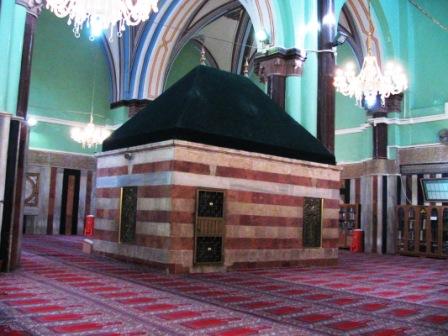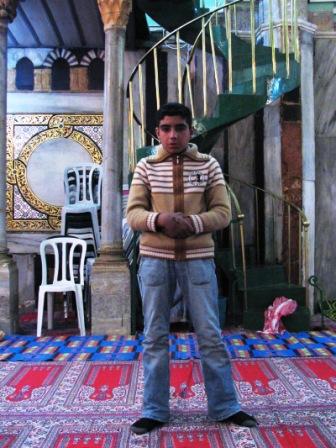|
 12:
Prayer at the Ibrahimi Mosque/Cave of Machpela, part 1 12:
Prayer at the Ibrahimi Mosque/Cave of Machpela, part 1 
By Skip Schiel
Photos: Ibrahimi mosque, boy at prayer in mosque, Hebron , November 2004
From the Travels of Reb Benjamin of Tudelah (1173):
And in the valley is the Cave of Machpela, if a Jew should pay the Ishmaelite watchman, he will open for him an iron gate. From there one descends stairs with a candle in hand. Upon reaching the third cave one will find six graves. These are the graves of Abraham, Isaac and Jacob, and opposite them, Sarah, Rebecca and Leah, and inside the cave are many barrels, filled with bones of Israelites who would bring the bones of their dead to the Cave in the age of Israel.
A most profound experience, visiting and then meditating in the Ibrahimi mosque in the Old City of Hebron --serenity in the midst of the nub of the Occupation, within 60 feet of the tombs of Abraham and Sarah, Isaac and Rebecca, Jacob and Leah . Jews call the city Chevron, and Palestinians, Al-Khalil, both names mean brother.
Last weekend I was in Hebron to photograph for the Ecumenical Accompaniers and the Christian Peacemaker Team, their project of accompanying children to their schools. Accompaniment is necessary because the Israeli settlers--among the most extreme in Palestine (and often from the United States )--often attack the children, spitting at them, throwing rocks, pulling head scarves off, and cursing. However, all was blessedly civil during the three days I was there.
With some free time, I wandered off into the labyrinthine Old City , what remains of it since many Palestinians have chosen to flee. Last year with the Fellowship of Reconciliation delegation, some of us visited the Tombs of the Patriarchs and Matriarchs, a curious sharing of holy sites, a dynamic juxtaposition of claims, one of the flashpoints in the Middle East . Israeli Jews call the site, the Cave of Ha-Machpela ( which means, as far as I can determine, cave, producing a redundancy ) and Palestinians call the site, Al-Haram Al-Ibrahimi, the Abraham Sanctuary, or Ibrahimi Mosque . Last year I visited only the Jewish side, the synagogue, this year, the mosque.
I entered after Border Police thoroughly examined my bags and asked questions about my religion.
I confess here that I committed apostasy, out of ignorance, and with some truth mixed in.
--Are you Christian?” the Border Police woman asked me.
Thinking I might be denied entrance if I answered yes, and not sure I am a Christian in the sense of believing in the divinity of Jesus, I answered:
--No.
After some reflection on her part and after consulting with peers, she waved me in.
The mosque is huge, cavernous, in two parts, very quiet (with no one but me and a few others present), and centers on several tall shrines which resemble log cabins. They enclose cenotaphs, 4 meter high bulbous forms, which are alleged to stand over the actual tombs buried in limestone some 15 meters below. I viewed the cenotaphs thru grated windows. And I tried to imagine 45 feet below, what this might look like, smell like, how emanations might feel that many have fought to control.
But this day was peaceful. I settled into meditation, sitting against a rear wall, happy to be praying in my manner in such a holy site. Earlier, a man claiming to be an imam escorted me thru the building, pointing out the bullet marks left by the massacre in 1994 by the settler from the USA, esteemed by some, vilified by many, Jews and Palestinians alike, the notorious surgeon from Brooklyn, Baruch Goldstein. He claimed Muslim worshippers had hidden weapons under these floors and would attack soon. So, pre-emptively, he entered the mosque during prayer with an assault rifle and killed some 30 people before being himself killed. This incident led to riots throughout the Occupied Territories , and many more deaths. It also brought to Hebron the Temporary International Presence in Hebron , a most stellar and courageous group, but this is another story.
So I sat there, in repose, concentrating on my breathing, absorbing the holiness of this place. When--and I do profess to be a photographer, often hurt and puzzled when people stop me from photographing during prayer or worship--a boy abruptly stood before me. He gestured:
--Please photograph me while I pray.
Thus, my second form of prayer, photography.
Hebron , the tombs, the Goldstein massacre
Another view
The excursion into the actual caves of Machpela, Noam Arnon’s first-person account of the venture into Mar’arat HaMachpela--
The eviction of an illegal settlement in Hebron
Temporary International Presence in Hebron
|
|



